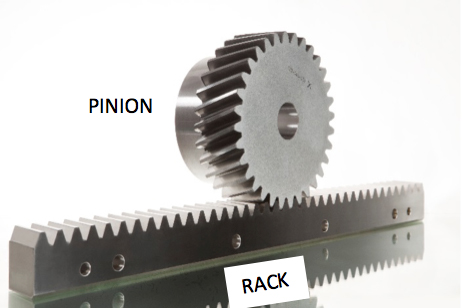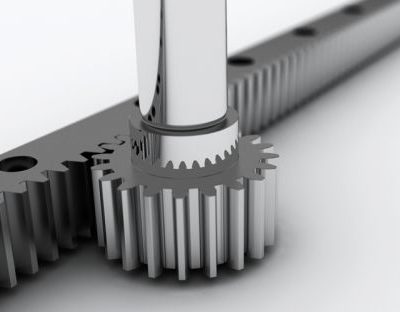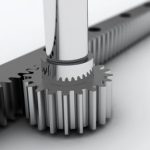The Rack and Pinion System is the primary building block of a linear axis drive. This system consists of a standard range of straight (spur), circumferential pitch, and helical racks and pinions. The modular design permits rack segment lengths from 0.5 to 2 meters to be linked together end to end achieving any desired travel length from standard components.
Rack and pinion parts are available with different materials, heat treatments and quality levels to insure the correct balance of power, precision and price to meet the application requirements.
- Six quality levels available, up to Hardened & Ground (AGMA 13)
- Nine standard Modules from Module 1.0 to 10.0 (Diametral Pitch, P, 25.4 to 2.54)
- Standard rack lengths up to 2.00 meters; longer travel lengths can easily be achieved by mounting the racks end-to-end
- Special/modified designs are possible
- Preloaded dual pinion gearboxes to eliminate axis backlash
Q: What is a rack & pinion?
A: A rack & pinion is a linear actuator consisting of a rotating pinion combined with a translating rack. As the pinion rotates it causes the rack to be driven linearly and vice-versa.

Q: Does Andantex make racks & pinions for automobile and truck steering mechanisms?
A: No, Andantex racks & pinions are designed and manufactured for use on industrial machinery such as automation equipment, robot 7th axis, machine tools, cutting machines (waterjet, laser, plasma, etc.), woodworking CNC routers, lifting equipment, composite machinery (automated fiber placement, trim & drill machines) to name a few.
Q: What is the difference between a straight & helical rack?
A: A straight rack has teeth parallel to the axis of rotation. A helical rack has teeth at an angle to the direction of rotation.

Helical racks have a higher contact ratio (number of rack and pinion teeth in contact) allowing them to transmit more torque for the same module. Furthermore, the helical racks generate less noise especially when operating at high speeds (> 1 M/s). The only drawback is that helical racks create an axial load that must be supported by the bearings and machine frame.
Q: What is the difference between Diametral Pitch, P, and Module, M?
A: Diametral Pitch is used in the US imperial system as: P = Number of Teeth/Pitch Diameter (inch) with units 1/inch. Module M is used in the Metric system and is defined as:
M = Pitch Diameter (mm)/Number of Teeth.
The two values are related by P = 25.4/M.
The standard tooling to make diametral pitch racks is different than Module racks. Andantex specializes in Metric Module racks.
Q: What is circular pitch p?
A: Circular pitch, p, is the distance from a point on the pitch line of one tooth to the same point on the next tooth.

Q: Why does Andantex use a helix angle of 19°31’42” (19.5283°)?
A: This helix angle allows racks to be made in exactly 0.5-meter, 1.0 meter and 2.0-meter lengths because the circular pitch is an exact number. For example, a module 6, helical rack has a circular pitch, p defined as:
p = π * M/cos Helix Angle = π*6/cos 19.5283° = 20.000 mm
Q: What does the quality number mean?
A: The quality number defines a group of tolerances for all aspects of the gear teeth including runout, pitch error, profile error, lead error, total composite error and more. One number defines many different tolerances that are defined by international standards. A lower number indicates higher quality in the DIN system. In the USA, AGMA standard 2000-A88 higher numbers indicate higher quality. AGMA has developed a new standard, AGMA 2015-1-A01 that is similar to the DIN standard where lower numbers indicate higher quality. AGMA quality numbers that Andantex references are based on the older standard because most gear drawings still reference that standard.
Q: What length Rack & Pinion axis can be built with Andantex Racks?
A: The racks Andantex supplies are available in standard lengths of 0.5 M, 1.0 M and 2.0 M. These racks are designed to be installed for continuous mounting so they can be placed end to end to create any length axis. There is no limit to the axis length.
Q: How do you assemble the racks end to end?
A: The initial setting of the rack junction is made with a “companion” rack that sets the pitch from one rack to the next. The junction fine-tuning is accomplished by measuring the pitch height with a specific pin diameter for the rack module.
Q: Can Andantex help with the selection of a rack & pinion drive system for a new application?
A: Andantex has a very experienced staff of engineers and salespeople capable of optimizing the rack and pinion selection. We do need to know the requirements of the application. These can be communicated by filling out our rack and pinion application data sheet and forwarding the information. The data-sheet can be found by clicking on Request a Quote button below.
As an option, please feel free to give Andantex a call and we will E-Mail an application data sheet. Once we receive the data, we will provide a complete sizing calculation along with a parts list of selected components, quotation and 3D models.
Q: Can Andantex provide custom racks and pinions?
A: Yes, but please keep in mind that our production uses metric, module tooling so we are most cost-effective when we offer metric racks and pinions. It is often possible to provide a metric rack with similar dimensions to a diametral pitch rack. In this case, the pinion should also be changed.
Q: Can Andantex provide racks for corrosive environments?
A: Yes, Andantex can provide racks in stainless steel or coated steel.
Q: Do Rack & Pinion drives perform as well as ballscrews?
A: Yes, both systems can position within 10 microns (4/10,0000 in.) or better when properly preloaded and combined with linear scale feedback. Tolerances of 25 microns (.001 in.) can easily be achieved using encoder feedback and linear compensation. When an axis length exceeds 4 meters, rack and pinion drives perform better and are more cost-efficient than ballscrew.
Q: Do Andantex racks require lubrication?
A: Yes, we always recommend that the racks be lubricated with a thin film of grease to insure optimum load capacity and long life. Andantex offers a cost-effective automatic lubrication system to provide minimum quantity lubrication.
Q: Are Andantex Racks zero backlash?
A: Andantex has solutions to cancel all backlash in a rack and pinion drive for a true zero backlash system. The recommended backlash between a pinion and the gear rack is dependent on the quality of the two components. Better quality components can be set closer to reduce the amount of backlash without interference between the components.
Q: How fast can a rack and pinion system travel?
A: Rack and Pinion systems can achieve speeds of up to 5 m/s (1,000 ft/min)
Q: What size racks & Pinions does Andantex offer?
A: Module 1-10 is standard
Q: What is the delivery for standard racks & pinions?
A: Normally 4-6 weeks if not in our stock
Need help? Contact Us.


